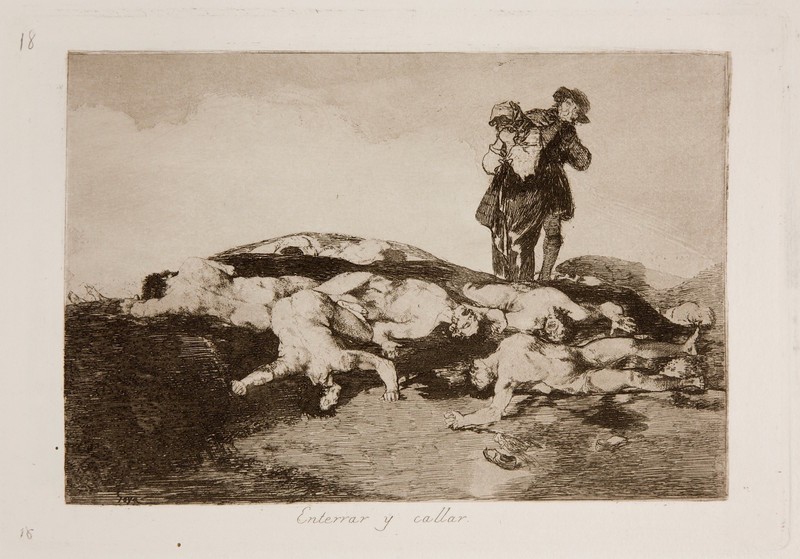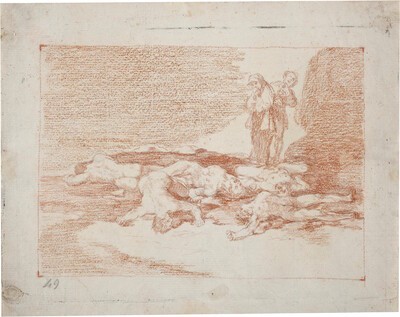- Cronología
- Ca. 1810 - 1812
- Dimensiones
- 162x234 mm
- Técnica y soporte
- Etching, burnished lavis, drypoint and burin
- Reconocimiento de la autoría de Goya
- Undisputed work
- Ficha: realización/revisión
- 30 Nov 2010 / 02 Jun 2023
- Inventario
- 225
Goya (lower left-hand corner).
See Sad presentiments of what must come to pass.
In the first state proof we can see some touches of drypoint on the chest of the corpse on the right-hand side, as well as some use of burin on the shadows on the ground. The signature, also done with burin, is in the lower left-hand corner.
The title was handwritten by Goya on the first and only print run that we know to have been made at the time, and which the painter gave to his friend Agustín Ceán Bermúdez. The title was engraved on to the copperplate at a later date, and no other modifications were made to the image for the first edition of the Disasters of War, which was printed by the Royal Academy of Fine Arts of San Fernando, Madrid, in 1863.
There is a preparatory drawing in the Prado Museum.
In the image we see two figures standing out against a pale background. They are looking at the macabre spectacle left behind by the war: a group of naked corpses. Both of these witnesses are covering their faces, although it is unclear whether they are crying or if they are holding their noses, just like the figure in etching no. 62, The deathbeds, is doing, to keep out the stench of the decomposing bodies.
Visually, this is one of the brightest images in the Disasters of War series; the sky is pale and clear, and so is the group of naked bodies left to their fate. This image also has a strong feeling of silence about it, especially in comparison with the other etchings, in which we can imagine the noise, screams and violence of battle. Despite the fact that these corpses are shown with their mouths gaping wide open, they can no longer shout or moan, nor plead for a better ending for themselves. The two observers have nothing to say either. All that is left to do is Bury them and keep quiet.
This etching can be considered alongside those others which depict groups of dead bodies, such as no. 12, This is what you were born for, nº 16, They avail themselves, nº 21, It will be the same, nº 22, All this and more, nº 23, The same elsewhere, nº 27, Charity, nº 48, A cruel shame!, nº 62, The deathbeds and nº 63, A collection of dead men.
The etching plate is conserved in the National Chalcography Museum (cat. 269)
-
GoyaMinistry of Foreing AffairsBurdeos1951organized by the Bordeaux City Hall, consultant editor Gilberte Martin-Méry. From May 16th to June 30th 1951cat. 7
-
Goya and his timesThe Royal Academy of ArtsLondon1963cat. 66cat. 235
-
De grafiek van GoyaRijksmuseum RijksprentenkabinetAmsterdam1970from November 13th 1970 to January 17th 1971cat. 66
-
Goya. Das Zeitalter der Revolucionen. Kunst um 1800 (1980 – 1981)Hamburger KunsthalleHamburg1980cat. 76
-
Francisco de GoyaMuseo d'Arte ModernaLugano1996exhibition celebrated from September 22nd to November 17th.cat. 18
-
Ydioma universal: Goya en la Biblioteca NacionalBiblioteca NacionalMadrid1996from September 19th to December 15th 1996cat. 213
-
Francisco Goya. Capricci, follie e disastri della guerraSan Donato Milanese2000Opere grafiche della Fondazione Antonio Mazzottacat. 98
-
Goya. Opera graficaPinacoteca del Castello di San GiorgioLegnano2006exhibition celebrated from December 16th 2006 to April 1st 2007p. 60
-
Goya en tiempos de guerraMuseo Nacional del PradoMadrid2008consultant editor Manuela B. Mena Marqués, from April 14th to July 13th 2008cat. 103
-
Goya et la modernitéPinacothèque de ParisParís2013from October 11st 2013 to March 16th 2014cat. 57
-
2022
-
Goya, grabadorMadridBlass S.A.1918cat. 120
-
Goya engravings and lithographs, vol. I y II.OxfordBruno Cassirer1964cat. 138
-
Vie et ouvre de Francisco de GoyaParísOffice du livre1970cat. 1020
-
Catálogo de las estampas de Goya en la Biblioteca NacionalMadridMinisterio de Educación y Cultura, Biblioteca Nacional1996cat. 213
-
El Libro de los Desastres de la GuerraMadridMuseo del Prado2000II, pp. 40-42
-
ParísPinacoteca de París2013p. 128
-
Goya. In the Norton Simon MuseumPasadenaNorton Simon Museum2016pp. 114-151
-
Museo de Bellas Artes de Badajoz y Diputación de Badajoz2022p. 60

